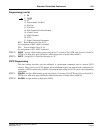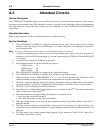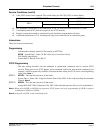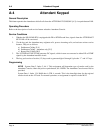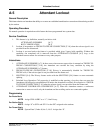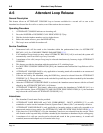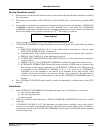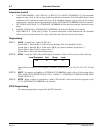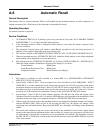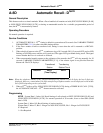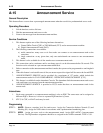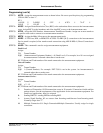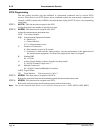
NEAX2400 IPX Feature Programming Manual
NDA-24297, Issue 1
Page 13
Attendant Override A-7
Service Conditions (cont’d)
4. Each tone burst is 0.08 seconds in duration and is used to alert both parties that the Attendant is overriding
the conversation.
5. This feature can be denied on DICTATION [D-3] and PAGING [P-1] connections by assigned ARTD
data.
6. It is possible, via system data, to completely disable the sending of warning tone during an ATTENDANT
OVERRIDE connection. Normally the two burst Warning Tone is sent when the ATTENDANT
OVERRIDE connection is initiated and then is repeated approximately every 15 seconds. The initial tone
burst is also disabled. If the trunk is connected to a D
term
, the display is as follows:
After 5 seconds, the display returns to the normal Conference display, CONF.
7. ATTENDANT OVERRIDE is temporarily denied and reorder tone heard if any of the following features
are active:
a.) EXECUTIVE RIGHT-OF-WAY [E-1]: If the called trunk is connected to a line on which
EXECUTIVE RIGHT-OF-WAY is being used.
b.) Trunk Restriction: If the called tie trunk was routed to reorder tone as a result of trunk restriction.
c.) SPECIAL DIAL TONE [S-2]: If the called trunk is on hold.
d.) ATTENDANT CAMP-ON WITH TONE INDICATION [A-1]: If the called trunk is camped-on
to a busy station.
e.) SERIAL CALL [S-15]: ATTENDANT OVERRIDE is denied to the parties held on the console.
f.) ATTENDANT INTERACTION: During the normal operation of PBX features, situations may
arise whereby a trunk may be connected to an ATTENDANT CONSOLE [A-3]. While the trunk
is connected to the ATTENDANT CONSOLE [A-3] or is in queue at an ATTENDANT
CONSOLE [A-3], the Attendant at the Console or an Attendant at any other Console (when
multiple consoles are provided) is not allowed to bridge on the connection. The trunk must be
connected to a station in a talking mode in order for the ATTENDANT OVERRIDE feature to
function.
8. The ATTENDANT CONSOLE cannot specify a trunk accommodated in a different node in the FCCS
network.
Interactions
1. With ATTENDANT OVERRIDE, the following trunk types may be verified (busy or idle status):
a.) One-way incoming trunks
b.) One-way outgoing trunks
c.) Bothway trunk
2. Trunks in a station-to-trunk connection or TRUNK-TO-TRUNK CONNECTION [T-10] can be verified
when busy.
3. ATTENDANT LOCKOUT [A-5]: The Attendant is prevented from overriding a busy trunk which is
connected to a loop held at the Attendant Console. Since the lockout feature applies only to calls held on
an Attendant Console loop, ATTENDANT OVERRIDE of those trunks will be denied and the Attendant
will hear reorder tone.
OPE BV
(Time Display)



